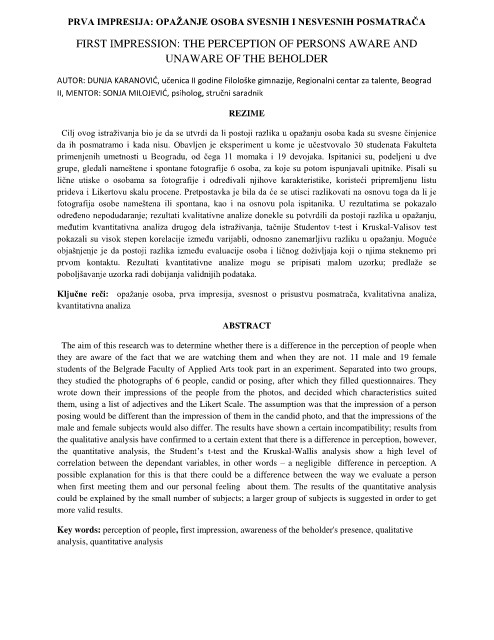Page 428 - Srednje skole - radovi
P. 428
PRVA IMPRESIJA: OPAŽANJE OSOBA SVESNIH I NESVESNIH POSMATRAČA
FIRST IMPRESSION: THE PERCEPTION OF PERSONS AWARE AND
UNAWARE OF THE BEHOLDER
AUTOR: DUNJA KARANOVID, učenica II godine Filološke gimnazije, Regionalni centar za talente, Beograd
II, MENTOR: SONJA MILOJEVID, psiholog, stručni saradnik
REZIME
Cilj ovog istraživanja bio je da se utvrdi da li postoji razlika u opažanju osoba kada su svesne činjenice
da ih posmatramo i kada nisu. Obavljen je eksperiment u kome je učestvovalo 30 studenata Fakulteta
primenjenih umetnosti u Beogradu, od čega 11 momaka i 19 devojaka. Ispitanici su, podeljeni u dve
grupe, gledali nameštene i spontane fotografije 6 osoba, za koje su potom ispunjavali upitnike. Pisali su
lične utiske o osobama sa fotografije i određivali njihove karakteristike, koristeći pripremljenu listu
prideva i Likertovu skalu procene. Pretpostavka je bila da će se utisci razlikovati na osnovu toga da li je
fotografija osobe nameštena ili spontana, kao i na osnovu pola ispitanika. U rezultatima se pokazalo
određeno nepodudaranje; rezultati kvalitativne analize donekle su potvrdili da postoji razlika u opažanju,
međutim kvantitativna analiza drugog dela istraživanja, tačnije Studentov t-test i Kruskal-Valisov test
pokazali su visok stepen korelacije između varijabli, odnosno zanemarljivu razliku u opažanju. Moguće
objašnjenje je da postoji razlika između evaluacije osoba i ličnog doživljaja koji o njima steknemo pri
prvom kontaktu. Rezultati kvantitativne analize mogu se pripisati malom uzorku; predlaže se
poboljšavanje uzorka radi dobijanja validnijih podataka.
Ključne reči: opažanje osoba, prva impresija, svesnost o prisustvu posmatrača, kvalitativna analiza,
kvantitativna analiza
ABSTRACT
The aim of this research was to determine whether there is a difference in the perception of people when
they are aware of the fact that we are watching them and when they are not. 11 male and 19 female
students of the Belgrade Faculty of Applied Arts took part in an experiment. Separated into two groups,
they studied the photographs of 6 people, candid or posing, after which they filled questionnaires. They
wrote down their impressions of the people from the photos, and decided which characteristics suited
them, using a list of adjectives and the Likert Scale. The assumption was that the impression of a person
posing would be different than the impression of them in the candid photo, and that the impressions of the
male and female subjects would also differ. The results have shown a certain incompatibility; results from
the qualitative analysis have confirmed to a certain extent that there is a difference in perception, however,
the quantitative analysis, the Student’s t-test and the Kruskal-Wallis analysis show a high level of
correlation between the dependant variables, in other words – a negligible difference in perception. A
possible explanation for this is that there could be a difference between the way we evaluate a person
when first meeting them and our personal feeling about them. The results of the quantitative analysis
could be explained by the small number of subjects; a larger group of subjects is suggested in order to get
more valid results.
Key words: perception of people, first impression, awareness of the beholder's presence, qualitative
analysis, quantitative analysis

